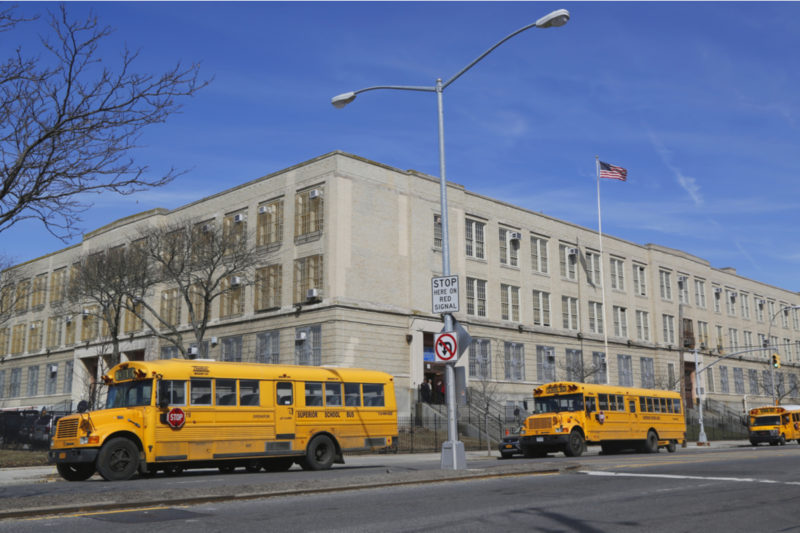The Struggle to Get Education Away from the State

Education reform is a perennial hot-button issue, with teachers’ unions like the American Federation of Teachers and the National Education Association spending vast sums to elect their preferred candidates and lobby them for reforms they find favorable. Interest in free-market alternatives to government education has increased since the middle of the 1950s, when Milton Friedman tried to resolve the tension between schooling’s possible spillover benefits (which provide a plausible case for government involvement) and government inefficiency.
Friedman and many others noted that while the presence of spillover benefits might be an argument for government subsidy, it is not by itself an argument for government provision. He argued in favor of education vouchers whereby the government would provide funding but a competitive marketplace would actually provide the schooling. School choice has a lot of prominent academic proponents (most notable among them, perhaps, is Stanford University’s Caroline Hoxby, who I will note is curiously absent from this volume), but it has faced fierce opposition from teachers’ unions and others who deride it as a thinly-veiled effort to redirect government money into private, religious, or corporate pockets at best or as an effort to covertly re-segregate schools using the language of free markets and individual liberty.
In Education in the Marketplace: An Intellectual History of Pro-Market Libertarian Visions for Education in Twentieth Century America, Kevin Currie-Knight of East Carolina University takes us on a guided tour of free-market ideas about education as explained in the twentieth century by Albert Jay Nock, Frank Chodorov, Ayn Rand, Murray Rothbard, Milton and Rose Friedman, Myron Lieberman (where he locates a distinct public choice approach), and others. He closes by pitting former school choice proponent Diane Ravitch’s proposals for reform against Ron Paul’s.
Education in the Marketplace arrives at a very interesting time and complements two other books that have appeared since the beginning of 2018 that question the romantic view of schooling: Bryan Caplan’s The Case Against Education: Why the Education System is a Waste of Time and Money (which I discuss here) and Jason Brennan and Phil Magness’s Cracks in the Ivory Tower: The Moral Mess of Higher Education (which I discuss here and here). Both ask that we consider education as it actually is and as it actually performs according to the best data we have. Instead, we indulge romantic and unlikely visions about what education could be in the best world we can imagine and then say, when things don’t turn out that way, that we’re just not doing enough of it or just doing it the wrong way.
What is it, though, about classical liberal ideas that makes them worthy of a separate treatment with respect to education? Citing Brennan, Currie-Knight explains how the libertarian ideal is a society built on consent (p. 3). To this end, he chronicles a series of radical visions for education that diverge sharply from the mainstream understanding of schooling as something governments do in order to make us smart, holy, virtuous, or just civic-minded. He begins with Albert Jay Nock, who was against state schooling but who worried that if left wholly to their own devices people would choose to learn the wrong things.
As the father of three children who make questionable choices about how they spend their time and the media they consume, I have a certain degree of sympathy for Nock’s point and will note that a lot of our cultural output (and many of our educational institutions) are sponsored by states or by philanthropists who, presumably, want to see us make good choices with respect to the cultural and moral choices we make. And “(b)y culture, Nock meant ‘knowledge of the best that has been thought and said in the world’” (quoted on page 27). A cursory glance at the prime-time TV listings should be enough to convince us that the best people have said, written, and thought is not at the top of our priority list.
Here, though, we run into knotty questions about cultural preservation. Who, I wonder, should we trust to steward culture? Incidentally, Currie-Knight’s project is made much easier by the (private) efforts of organizations like the Liberty Fund, the Foundation for Economic Education, and the Ludwig von Mises Institute–organizations that have devoted considerable resources to publishing programs making it easy for anyone with an Internet connection to find the finest that has been written in the classical liberal tradition.
He begins with Albert Jay Nock on the basis of what he admits (p. 10) was an error: after seeing how Nock defended markets and criticized government education, Currie-Knight simply
“assumed…that his solution to the ills of state education would be markets in education. Further research revealed Nock to be as much a skeptic of markets in education as a critic of state education. Yet this itself makes for an interesting reason to start a project like this with an exploration of Albert Jay Nock. Particularly as Nock’s libertarian thought was such an influence on Frank Chodorov–the second intellectual I examine–there is an interesting story to tell about why, for all his libertarianism, Nock did not support markets in education the same way as in other areas, while Chodorov did.” (pp. 10-11)
Nock’s importance in part came from his influence on Chodorov. He was a pessimist, in short, about markets providing the right education, arguing that what people want is not necessarily what they should want and what they would want if they know what is good for them (p. 23). How is Nock weighing the differences between the for-profit and non-profit sector in providing schooling?
Currie-Knight points out that Nock was “influenced heavily by philosopher Herbert Spencer” (p. 25). Spencer is, of course, notorious (albeit unfairly) on the left for “social darwinism.” To what extent did Spencer’s vision here influence Nock’s ideas about schooling? On page 42, he points out that Nock was “deeply influenced” by Henry George. How so, and how did this manifest itself in the works of Nock and Chodorov specifically? Frank Chodorov agreed with Nock about the need for schooling as a means of preserving civilization, but he trusted parents more than he trusted the state “because parents had more vested interest in ensuring their children received quality education” (p. 57. Currie-Knight’s words).
The move for government schooling was driven in no small part by an unhealthy dose of anti-Catholic bias (p. 46). This was, of course, a problem, and it was one Frank Chodorov pointed out: it might take some time to develop a system where there are enough schools cheap enough for everyone. As Pauline Dixon and other researchers with the E.G. West Centre at the University of Newcastle point out, though, this is a problem that the world’s poorest are solving by developing their own low-cost private schools (readers surprised that West does not get his own chapter would do well to remember that Currie-Knight’s subject is American libertarians–he gets his due especially on pp. 112ff).
Our understanding of schooling is incomplete insofar as we usually consider it an unalloyed good. A comparative-institutional approach to schooling and the analysis thereof would at least take into consideration the possibility that schooling provides public bads, as well, insofar as schools indoctrinate students into well-intentioned but tragically-misled ideologies. There is, of course, a devil in the institutional details, as well: who gets to define exactly what we mean by education? It is more than an effort to dodge a difficult question. Ideally, when we talk about “education” we are actually talking about something that can, at least in principle, be measured and defined objectively. This leads us, I think, to an under-appreciated aspect of school choice and competition: “education” is defined in the process of its emergence.
The most controversial name in the book (due to name recognition) is Milton Friedman, the late-20th-century lion of libertarian ideas who proposed education vouchers in the mid-1950s. To Friedman, government’s role in schooling came from funding by redistribution, not from administration (cf. pp. 11-12). As Currie-Knight points out (pp. 108-9), Friedman was basically asking for a GI Bill for K-12 education. Educational choice at the college level has helped produce in the United States the world’s foremost system of higher education. The same, perhaps, could happen at the K-12 level.
As with virtually everything else, Friedman was not asking “what is ideal?” Rather, he was asking “what is the most prudent course of action that will lead us to at least a marginally better outcome?” Friedman is an exemplar of what Thomas Sowell called The Constrained Vision. He has taken a lot of fire for his voucher proposal and his grudging admission that in the short run, segregationists might use them to keep schools segregated. He believed, however, that in the long run school choice would lead to greater integration, and there is at least some evidence from studies of Virginia’s tuition grant program that some parents were using the grants to send their children to integrated schools (AIER’s Phil Magness explains here).
School choice was not, as it happens, invented out of whole cloth by people seeking to maintain segregation in the wake of the Brown vs. Board of Education decision. Indeed, they go back to John Stuart Mill (pp. 106-7).
A close second for “most controversial name in the book” would be Ayn Rand. Rand and Isabel Paterson–and Education in the Marketplace is a useful introduction to them and their characters–were very skeptical of government schooling. Rand distrusted it because of homogenization (p. 62); The God of the Machine author Paterson agreed with Rand that students were being taught collectivism in public schools (pp. 66-67, referencing specific progressive proposals). As Currie-Knight argues, progressive educators of the time saw the schools as vehicles for social change. To Rand, tax-financed schools were out of the question because they forced people to subsidize others and to support schools they didn’t wish to support.
One of the major libertarian criticisms of government schooling comes from concern over what schools teach. Murray Rothbard, a brilliant writer, asked a penetrating question: what if we had a government-controlled press the way we have government-controlled education? Most of us would recoil at the idea and would be loath to move in that direction. At the same time, however, it seems reasonable to think that if we had state-controlled media, people would ask the same questions and have the same fears about a privatization scheme. Who will ensure that the poor have access to news? Who will ensure that the news is “fair and balanced”? I am not so sure I trust the men and women of the educational system, to borrow Adam Smith’s phrase, to do it for me (cf. Currie-Knight, pp. 110-11).
What, we might ask, about people who will fail to choose well? It’s certainly a legitimate concern, and one worth taking very seriously. However, a quick look over any set of local library shelves does not exactly inspire in me a lot of confidence that intellectual, moral, and cultural surrogates will choose wisely on my behalf. We have to take seriously the idea that schooling (as distinct from education) subsidizes a lot of public bads. I’m prepared to believe that preserving the greatest that people have thought and written and making it available for everybody is a very good idea. I am a lot less prepared to put cartoon strips, bodice-rippers, and new age pseudoscience in that category–and there is plenty of that on the shelves of the libraries we patronize.
While Currie-Knight is explicitly focused on 20th century thinkers, I think the reader would benefit from a clearer and more complete connection between his subjects and their forerunners like Henry George, Herbert Spencer, John Stuart Mill, and Thomas Paine. What were the specifics of the influence, and to what extent did critics raise objections? A lot of people recoil from mentions of Spencer as a “social Darwinist;” might his influence taint (for example) the beliefs of Albert Jay Nock and Frank Chodorov? Moving into early 21st century scholarship, what is it about schooling that makes people–even economists who believe the evidence points in the direction of vouchers–embrace it so, as Daniel Klein discussed in his paper “The People’s Romance”?
In all, Education in the Marketplace is a valuable contribution to our understanding of how classical liberals think and have thought about schooling. Most people simply take it for granted that the state should own the means of educational production and glory in the collective action underlying that arrangement precisely because it is collective. There are a lot of ways this can be extended–by diving in to Diane Ravitch’s conversion from school choice advocate to school choice critic, for example.
Intellectual historians and education historians might be disappointed by the lack of archival digging, but I suspect that more than one person will see in Education in the Marketplace a fertile source of new research ideas that take advantage of what might be found among the papers of Milton Friedman, Ayn Rand, and others. A classical liberal vision for education–and Education in the Marketplace is part of the Palgrave Studies in Classical Liberalism series–is a refreshing departure from the norm, and it is clearly something that needs to be taken more seriously in the coming years.










